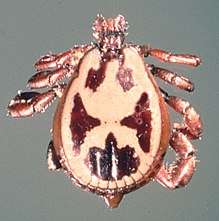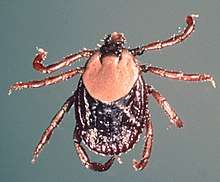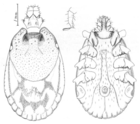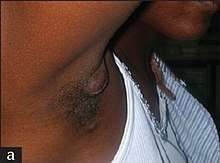Rhipicephalus pulchellus
| Rhipicephalus pulchellus | |
|---|---|
 | |
| Dorsal view of male. | |
 | |
| Dorsal view of female | |
| Scientific classification | |
| Kingdom: | Animalia |
| Phylum: | Arthropoda |
| Subphylum: | Chelicerata |
| Class: | Arachnida |
| Order: | Ixodida |
| Family: | Ixodidae |
| Genus: | Rhipicephalus |
| Species: | R. pulchellus |
| Binomial name | |
| Rhipicephalus pulchellus | |
| Synonyms[4]:160 | |
| |
Rhipicephalus pulchellus (zebra tick or yellow back tick) is a species of hard tick. It is a very common tick in the Horn of Africa, with a habitat of the Rift Valley and eastward. It hosts upon a wide variety of species, including livestock, wild mammals, and humans, and can be a vector for various pathogens. The adult male has a distinctive black and ivory ornamentation on its scutum.
Taxonomy and names


It was described by Carl Eduard Adolph Gerstaecker, who initially placed it in the genus Dermacentor[5] due to the ornamentation;[9]:40 all Dermacentor ticks are ornate.[2]:29 Its syntypes are at the Museum für Naturkunde.[10] Georges Neumann transferred this species to Rhipicephalus in 1897.[11][12] R. I. Pocock described a junior synonym, R. marmoreus, in 1900; its holotype was deposited at the Natural History Museum, London.[6] By 1901, Neumann had synonymized it with R. pulchellus.[13]
In 1926, Maria Tonelli-Rondelli described a subspecies R. p. humeralis, but in 1949, Fritz Konrad Ernst Zumpt reclassified it as its own species, R. humeralis.[9]:220
In 1904, Neumann circumscribed a new subgenus, (Eurhipicephalus), and included among its species R. (E.) pulchellus.[7] Aldo Castellani and Albert J. Chalmers then referred to this species as Eurhipicephalus pulchellus, treating Neumann's subgenus as its own genus.[8][14] B. I. Pomerantsev circumscribed a new Rhipicephalus subgenus (Lamellicauda) in 1936, which included R. (L.) pulchellus.[14][4]
J. A. T. Santos Dias circumscribed a subgenus, (Tendeirodes) including R. (T.) pulchellus and the three other rhipicephalids with ornamentation, i.e., R. (T.) dux, R. (T.) humeralis, and R. (T.) maculatus, but this subgenus is not recognized by Jane Brotherton Walker and colleagues.[9]:156 In 1998, Pierre-Claude Morel created a pulchellus species group within the nominate subgenus (Rhipicephalus) consisting of these four species.[4]:159–160
Based on the larva and nymph forms of Rhipicephalus species, Walker and colleagues placed R. pulchellus in the R. appendiculatus species group, consisting of R. appendiculatus, R. armatus, R. carnivoralis, R. duttoni, R. humeralis, R. maculatus, R. muehlensi, R. nitens, R. pulchellus, R. sculptus, and R. zambeziensis.[9]:602
In Neumann's 1901 description of R. maculatus,[13]:273–274 he mistakenly described female specimens of R. pulchellus as representing the female of this new species.[15][12][4]
The specific epithets pulchellus and marmoreus are Latin adjectives meaning "beautiful little" and "made or consisting of marble", respectively; the word pulchellus is a diminutive of pulcher "beautiful".[16][17] These refer to the male scutal pattern.[9]:365 It is also known by the common name "zebra tick"[18] both due to its black and white ornamentation and having the zebra as a frequent host.[19] It is also sometimes known as the "yellow backed tick".[20][21]
Description
Adult male

The males have ivory ornamentation surrounding the edge of its scutum and much of its center.[9]:47 The male gnathosoma is significantly longer than it is broad, with dimensions of .84 mm × .69 mm (0.033 in × 0.027 in) to 1.07 mm × .83 mm (0.042 in × 0.033 in). Its conscutum measures 3.44 mm × 2.29 mm (0.135 in × 0.090 in) to 4.61 mm × 3.14 mm (0.181 in × 0.124 in).[9]:367
Adult female

The female gnathosoma is slightly longer than it is broad, with dimensions of .8 mm × .77 mm (0.031 in × 0.030 in) to 1.02 mm × .98 mm (0.040 in × 0.039 in). Its scutum measure 1.82 mm × 1.68 mm (0.072 in × 0.066 in) to 2.5 mm × 2.17 mm (0.098 in × 0.085 in). Its scutum is mostly ivory colored and its alloscutum is dark brown.[9]:367
Hosts
This tick has been found on many species, including both livestock and wild animals, particularly ungulates; common hosts include Burchell's and Grevy's zebra, the black rhinoceros, and antelopes like the gemsbok, eland, and hartebeest.[9]:371 In one study conducted in Kenya, hundreds of specimens were found on Masai giraffes.[22]
They have been found on baboons in the Amboseli region of Kenya near Mount Kilimanjaro, although they only made up 1.8% of all ticks recorded in this study.[23] These ticks have also been known to have elephants as their hosts.[24]
Although they far less frequently parasitize birds than they do mammals, there are examples of the ostrich and the yellow-necked francolin as hosts for this species as well.[9]:373
It's a very common tick of cattle; in some parts of Ethiopia, ninety percent of all ticks collected from cattle and camels are R. pulchellus. This tick is present on eighty percent of cattle and individuals are hosts to over one thousand of this tick each.[25]
In one study, adult ticks were found on their hosts' neck and belly (45%), head (36%), forelegs (7%), hump region (13%), and hing legs (3%), with immature ticks found on the head and forelegs.[22]
Humans

Immatures have been known to host on legs of humans.[9]:371 The tick has been described as having a "strong affinity for human being"; ulcers generally form where larvae and nymphs feed on humans, and adults have also been found feeding on humans.[26]
Disease transmission
Many pathogens harmful to humans and other animals can be transmitted by this tick.[9]:374–375 The Dugbe virus has been isolated from R. pulchellus collected from sheep in Ethiopia.[27] There is also evidence that this tick can transmit Rickettsia conorii as guinea pigs tested positive for its antibodies after being hosted on.[28] One study suggested a possible link between this tick and typhus due to a similar distribution in Kenya although transmission was unsuccessful in laboratory settings.[26]
The Crimean–Congo hemorrhagic fever virus has been extracted from this tick.[25] The West Nile virus has also been extracted from R. pulchellus.[29]
It has also been shown to transmit Nairobi sheep disease,[25] and is likely its main vector in northern Somalia.[30] It's the main vector for the Kismayo virus.[31] The piroplasm Theileria taurotragi has R. pulchellus as one of its main vectors.[32]
Predators
The red-billed oxpecker regularly eats this tick.[33]
Habitat and distribution
This tick inhabits the Afrotropical biogeographic realm.[34] There have been reports of it in the Palearctic, namely in the Giza Governorate, Egypt[35] but some researchers are hesitant about listing the Palearctic in its distribution based on just that report.[34]
Adult ticks looking for hosts inhabit scrub and long grass areas.[22]
It occurs in the Horn of Africa, particularly in the Rift Valley and eastward.[9]
It lives between elevations of 500 and 2,000 metres (1,600 and 6,600 ft) in semi-arid bushlands and plains with an annual rainfall of 100–800 mm (3.9–31.5 in).[25]
One study predicted that its habitat range will increase throughout 2100 due to climate change.[36]
It is most active during the rainy season.[25]
Population
It is one of the most common ticks in the Horn of Africa.[9]:371
It was the most common tick in one study conducted in Haller Park, Kenya.[22] In the early 1900s, they were very common in Kenya's Athi Plains, and also found near Nairobi, Kiambu, and Ruiru.[37] They were the predominant tick collected from grass in the Kilimani area of Nairobi in a 1935 study.[26] One long-term study conducted in Laikipia, Kenya involved people walking for 400 m (1,300 ft) and counting the number of ticks found on their clothing; the average number of R. pulchellus adults peaked at three adults.[38]
As introduced species
There are reports of R. pulchellus being found on animals such as giraffes, zebras, rhinoceroses, and others which were imported into the United States,[39] but it does not seem to have become established anywhere in the Nearctic realm.[34]
References
- ↑ Horak, Ivan G.; Camicas, Jean-Louis; Keirans, James E. (2002). "The Argasidae, Ixodidae and Nuttalliellidae (Acari: Ixodida): A World List of Valid Tick Names". Experimental and Applied Acarology. 28: 52. doi:10.1023/A:1025381712339.
- 1 2 Barker, S. C.; Murrell, A. (2008). "Systematics and evolution of ticks with a list of valid genus and species names". In Bowman, Alan S.; Nuttall, Patricia A. Ticks: Biology, Disease and Control. Cambridge: Cambridge University Press. p. 24. doi:10.1017/CBO9780511551802.002. ISBN 9780511551802.
- ↑ Guglielmone, Alberto A.; Robbins, Richard G.; Apanaskevich, Dmitry A.; Petney, Trevor N.; Estrada-Peña, Agustín; Horak, Ivan G.; Shao, Renfu; Barker, Stephen C. (2010). "The Argasidae, Ixodidae and Nuttalliellidae (Acari: Ixodida) of the world: a list of valid species names" (PDF). Zootaxa. 2528: 25.
- 1 2 3 4 Camicas, Jean-Louis; Hervy, Jean-Paul; Adam, François; Morel, Pierre-Claude (1998). Les tiques du monde (Acarida, Ixodida) : nomenclature, stades decrits, hotes, repartition [The ticks of the world (Acarida, Ixodida) : nomenclature, described stages, hosts, distribution]. Paris: ORSTOM. ISBN 978-2-7099-1418-5.
- 1 2 3 Gerstaecker, A. (1873). "Dermacentor pulchellus, n. sp.". Gliederthiere (Insekten, Arachniden, Myriopoden und Isopoden). Baron Carl Claus von der Deckens reisen in Ost-Afrika. 3 (2). Leipzig: C. F. Winter. pp. 467–468; Pl. 18, Fig. 2.
- 1 2 3 Pocock, R. I. (1900). "On a Collection of Insects and Arachnids made in 1895 and 1897, by Mr. C. V. A. Peel, F.Z.S., in Somaliland, with Descriptions of new Species: Chilopoda and Arachnida". Proceedings of the Zoological Society of London. 1900 (1): 50. doi:10.1111/j.1096-3642.1890.tb01694.x; Pl. 3, Figs. 1–1d.
- 1 2 Neumann, L. G. (1904). "Notes sur les Ixodidés. — II". Archives de Parasitologie. 8 (3): 448–449.
- 1 2 Castellani, Aldo; Chalmers, Albert J. (1919). Manual of Tropical Medicine (3rd ed.). London: Ballière, Tindall and Cox. p. 713.
- 1 2 3 4 5 6 7 8 9 10 11 12 13 14 Walker, Jane B.; Keirans, James E.; Horak, Ivan G. (2000). The Genus Rhipicephalus (Acari, Ixodidae) A Guide to the Brown Ticks of the World. Cambridge: Cambridge University Press. doi:10.1017/CBO9780511661754. ISBN 9780511661754.
- ↑ Moritz, Manfred; Fischer, Sophie-Charlotte (1981). "Die typen der arachniden-sammlung des zoologischen Museums Berlin. IV. Ixodei". Mitteilungen aus dem Zoologisches Museum in Berlin. 57 (2): 358. doi:10.1002/mmnz.19810570205.
ZMB 2347 (3 ♂ sicc., Syntypen).
- ↑ Neumann, G. (1897). "Revision de la famille des Ixodidés (II. Ixodinæ)". Mémoires de la Sociéte Zoologique de France. 10: 399–402. BHL page 10107902.
- 1 2 Zumpt, F. (1942). "Die gefleckten Rhipicephalus-Arten. III. Vorstudie zu einer Revision der Gattung Rhipicephallus Koch". Zeitschrift für Parasitenkunde. 12 (4): 433–443. doi:10.1007/BF02121656.
- 1 2 Neumann, G. (1901). "Revision de la famille des Ixodidés (4e Mémoire)". Mémoires de la Société Zoologique de France. 14: 273. BHL page 10101270.
- 1 2 Doss, Mildred A.; Anastos, George (1977). Ticks and TIckborne Diseases. III. Checklist of Families, Genera, Species, and Subspecies of Ticks. Index-Catalogue of Medical and Veterinary Zoology. Special Publication. 3. Washington: U.S. Government Printing Office. p. 70. hdl:1969.1/91889.
- ↑ Warburton, Cecil (1912). "Notes on the Genus Rhipicephalus, with the Description of New Species, and the Consideration of some Species hitherto described". Parasitology. 5 (1): 16–17. doi:10.1017/S0031182000000032.
- ↑ Lewis, Charlton T.; Short, Charles (1879). "pulchellus". A Latin Dictionary. New York: Harper & Brothers. p. 1488.
- ↑ Lewis, Charlton T.; Short, Charles (1879). "marmoreus". A Latin Dictionary. New York: Harper & Brothers. p. 1115.
- 1 2 3 Cunliffe, Norman (1913). "The Variability of Rhipicephalus pulchellus (Gerstäcker, 1873), together with its Geographical Distribution". Parasitology. 6 (2): 204–216. doi:10.1017/S0031182000003048.
- ↑ Walker, A.R.; Bouattour, A.; Camicas, J.-L.; Estrada-Peña, A.; Horak, I. G.; Latif, A. A.; Pegram, R. G.; Preston, P. M. (2014). "Rhipicephalus pulchellus (Gerstäcker, 1873)". Ticks of Domestic Animals in Africa: A Guide to Identification of Species (PDF). Edinburgh: Bioscience Reports. pp. 200–201. ISBN 978-0-9545173-0-4. Archived (PDF) from the original on 12 August 2017.
- ↑ Theiler, Gertrud; Robinson, Britha N. (1953). "Ticks in the South African zoological survey collection. Part VII. Six lesser known African Rhipicephalids". Onderstepoort Journal of Veterinary Research. 26 (1): 113–119. hdl:2263/58697.
- 1 2 Wanzala, Wycliffe; Ondiaka, Sopher Natuluku (2013). "Tick-borne lymphadenopathy-like condition in an African woman in Kenya". Journal of Research in Medical Sciences. 18 (10): 918–921. ISSN 1735-7136. PMC 3897081. PMID 24497868.
- 1 2 3 4 Wanzala, W.; Okanga, S. (2006). "Ticks (Acari: Ixodidae) Associated with Wildlife and Vegetation of Haller Park along the Kenyan Coastline". Journal of Medical Entomology. 43 (5): 789–794. doi:10.1093/jmedent/43.5.789.
- ↑ Akinyi, Mercy Y.; Tung, Jenny; Jeneby, Maamun; Patel, Nilesh B.; Altmann, Jeanne; Alberts, Susan C. (2013). "Role of grooming in reducing tick load in wild baboons (Papio cynocephalus)". Animal Behaviour. 85 (3): 559–568. doi:10.1016/j.anbehav.2012.12.012. PMC 3961061. PMID 24659824.
- ↑ Fowler, Murray E. (2006). "Parasitology". In Fowler, Murray E.; Mikota, Susan K. Biology, Medicine, and Surgery of Elephants. Oxford: Blackwell. p. 167. doi:10.1002/9780470344484.ch12. ISBN 9780470344484.
- 1 2 3 4 5 Pegram, Rupert G.; Hoogstraal, Harry; Wassef, Hilda Y. (1981). "Ticks (Acari: Ixodoidea) of Ethiopia. I. Distribution, ecology and host relationships of species infesting livestock". Bulletin of Entomological Research. 71 (3): 339–359. doi:10.1017/S0007485300008397.
- 1 2 3 Roberts, J. Isgaer (1935). "The Ticks of Rodents and Their Nests, and the Discovery That Rhipicephalus sanguineus Latr. is the Vector of Tropical Typhus in Kenya". The Journal of Hygiene. 35 (1): 1–22. JSTOR 3859615. PMC 2170614. PMID 20475254.
- ↑ Wood, Owen L.; Lee, Vernon H.; Ash, John S.; Casals, Jordi (1978). "Crimean-Congo Hemorrhagic Fever, Thogoto, Dugbe, and Jos Viruses Isolated from Ixodid Ticks in Ethiopia". The American Journal of Tropical Medicine and Hygiene. 27 (3): 600–604. doi:10.4269/ajtmh.1978.27.600.
- ↑ Philip, Cornelius B.; Hoogstraal, Harry; Reiss-Gutfreund, Ruth; Clifford, Carleton M. (1966). "Evidence of Rickettsial disease agents in ticks from Ethiopian cattle". Bulletin of the World Health Organization. 35 (2): 127–131. hdl:10665/73725. PMC 2476120. PMID 5296996.
- ↑ Lwande, O.W.; Venter, M.; Lutomiah, J.; Michuki, G.; Rumberia, C.; Gakuya, F.; Obanda, V.; Tigoi, C.; Odhiambo, C.; Nindo, F.; Sang, R. (2014). "Genetic Diversity of West Nile virus Isolated from the tick, Rhipicephalus pulchellus, in Kenya". International Journal of Infectious Diseases. 21: 229–230. doi:10.1016/j.ijid.2014.03.899.
- ↑ Edelsten, R. M. (1975). "The distribution and prevalence of Nairobi Sheep disease and other tick-borne infections of sheep and goats in northern Somalia". Tropical Animal Health and Production. 7 (1): 29–34. doi:10.1007/BF02383239.
- ↑ Labuda, M.; Nuttall, P. A. (2008). "Viruses transmitted by ticks". In Bowman, Alan S.; Nuttall, Patricia A. Ticks: Biology, Disease and Control. Cambridge: Cambridge University Press. p. 262. doi:10.1017/CBO9780511551802.013. ISBN 9780511551802.
- ↑ Kocan, A. Alan; Waldrup, Kenneth A. (2001). "Piroplasms (Theileria spp., Cytauxzoon spp.)". In Samuel, William M.; Pybus, Margo J.; Kocan, A. Alan. Parasitic Diseases of Wild Mammals (2nd ed.). Ames: Iowa State University Press. p. 525. doi:10.1002/9780470377000.ch18b. ISBN 9780470377000.
- ↑ Peirce, M. A. (1975). "Ectoparasites from East African vertebrates". African Journal of Ecology. 13 (2): 153–156. doi:10.1111/j.1365-2028.1975.tb00131.x.
- 1 2 3 Guglielmone, Alberto A.; Robbins, Richard G.; Apanaskevich, Dmitry A.; Petney, Trevor N.; Estrada-Peña, Agustín; Horak, Ivan G. (2014). "R. Puchellus". The Hard Ticks of the World: (Acari: Ixodida: Ixodidae). Dordrecht: Springer. pp. 580–581. doi:10.1007/978-94-007-7497-1. ISBN 978-94-007-7496-4.
- ↑ Adham, F. K.; Abd-El-Samie, E. M.; Gabre, R. M.; Hussein, H. El. (2009). "Detection of tick blood parasites in Egypt using PCR assay I—Babesia bovis and Babesia bigemina" (PDF). Parasitology Research. 105 (3): 721–730. doi:10.1007/s00436-009-1443-8. PMID 19415329.
- ↑ Cumming, Graeme S.; Van Vuuren, Detlef P. (2006). "Will climate change affect ectoparasite species ranges?". Global Ecology and Biogeography. 15 (5): 493. doi:10.1111/j.1466-822X.2006.00241.x.
- ↑ Stordy, R. J. (1907). "Report of the Veterinary Department". East Africa Protectorate. Report for 1905–6. Colonial Reports—Annual. 519. London: Darling & Son. pp. 103–111. hdl:10111/UIUCAFRICANA:5530244_1905_1906.
- ↑ Keesing, Felicia; Allan, Brian F.; Young, Truman P.; Ostfeld, Richard S. (2013). "Effects of wildlife and cattle on tick abundance in central Kenya". Ecological Applications. 23 (6): 1410–1418. doi:10.1890/12-1607.1.
- ↑ Keirans, James E.; Durden, Lance A. (2001). "Invasion: Exotic Ticks (Acari: Argasidae, Ixodidae) Imported into the United States. A Review and New Records". Journal of Medical Entomology. 38 (6): 850–861. doi:10.1603/0022-2585-38.6.850.
Further reading
- Bekele, T. (2002). "Studies on Seasonal Dynamics of Ticks of Ogaden Cattle and Individual Variation in Resistance to Ticks in Eastern Ethiopia". Journal of Veterinary Medicine, Series B. 49 (6): 285–288. doi:10.1046/j.1439-0450.2002.00567.x.
- den Boer, J.; den Boer, M. H. (1980). "Aggregation in the questing tick, Rhipicephalus pulchellus". Physiological Entomology. 5 (2): 107–110. doi:10.1111/j.1365-3032.1980.tb00217.x.
- Clifford, Carleton M.; Flux, John E. C.; Hoogstraal, Harry (1976). "Seasonal and Regional Abundance of Ticks (Ixodidae) on Hares (Leporidae) in Kenya". Journal of Medical Entomology. 13 (1): 40–47. doi:10.1093/jmedent/13.1.40.
- Cowdry, E. V. (1925). "A group of microorganisms transmitted hereditarily in ticks and apparently unassociated with disease". Journal of Experimental Medicine. 41 (6): 817–830. doi:10.1084/jem.41.6.817. PMC 2130977. PMID 19869029.
- Fotheringham, W.; Lewis, E. Aneurin (1937). "East Coast fever; its transmission by ticks in Kenya Colony". Parasitology. 29 (4): 504–523. doi:10.1017/S0031182000025026.
- Lewis, E. Aneurin (1932). "Some Tick Investigations in Kenya Colony". Parasitology. 24 (2): 177. doi:10.1017/S0031182000020527.
- MacLeod, John (1970). "Tick infestation patterns in the southern province of Zambia". Bulletin of Entomological Research. 60 (2): 253–274. doi:10.1017/S0007485300040773. PMID 22894843.
- Nana, P.; Maniania, N. K.; Maranga, R. O.; Kutima, H. L.; Boga, H. I.; Nchu, F.; Eloff, J. N. (2010). "Attraction response of adult Rhipicephalus appendiculatus and Rhipicephalus pulchellus (Acari: Ixodidae) ticks to extracts from Calpurnia aurea (Fabaceae)" (PDF). Veterinary Parasitology. 174 (1–2): 124–130. doi:10.1016/j.vetpar.2010.08.016. PMID 20828936.
- Nana, P.; Ekesi, S.; Nchu, F.; Maniania, N. K. (2016). "Compatibility of Metarhizium anisopliae with Calpurnia aurea leaf extracts and virulence against Rhipicephalus pulchellus". Journal of Applied Entomology. 140 (8): 590–597. doi:10.1111/jen.12289. hdl:11189/5654.
- Neumann, L. G. (1911). "R. pulchellus". Ixodidae. Das Tierreich. 26. Berlin: R. Friedländer und Sohn. p. 43.
- Paoli, Guido (1916). "Ixodidi raccolti nella Somalia Italiana meridionale". Redia. 11: 276–278; Pl. 5, Figs. 3–5.
- Pavesi, Pietro (1895). "Esplorazione del Guiba e dei suoi affluenti compiuta dal Cap. V. Bottego. XVIII. Aracnidi". Annali del Museo Civico di Storia Naturale di Genova. 35: 535–536.
- Pavesi, Pietro (1895). "Aracnidi raccolti nel paese del Somalia dall'ing. L. Bricchetti-Robecci". Bollettino Scientifico. 17 (2): 45.
- Pegram, R. G. (1976). "Ticks (Acarina, Ixodoidea) of the northern regions of the Somali Democratic Republic". Bulletin of Entomological Research. 66 (2): 345–363. doi:10.1017/S000748530000674X.
- Tan, Angelina W. L.; Francischetti, Ivo M. B.; Slovak, Mirko; Kini, R. Manjunatha; Ribeiro, José M. C. (2015). "Sexual differences in the sialomes of the zebra tick, Rhipicephalus pulchellus". Journal of Proteomics. 117: 120–144. doi:10.1016/j.jprot.2014.12.014. PMC 4374903. PMID 25576852.
- Walker, Jane B. (1955). "Rhipicephalus pulchellus Gerstäcker 1873: A description of the larva and nymph with notes on the adults and on its biology". Parasitology. 45 (1–2): 95–98. doi:10.1017/S0031182000027463.
External links
